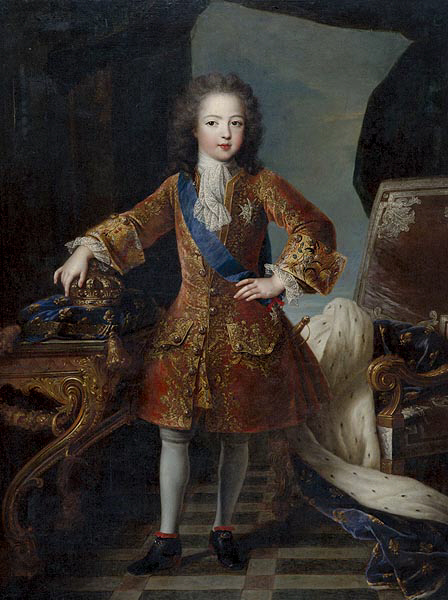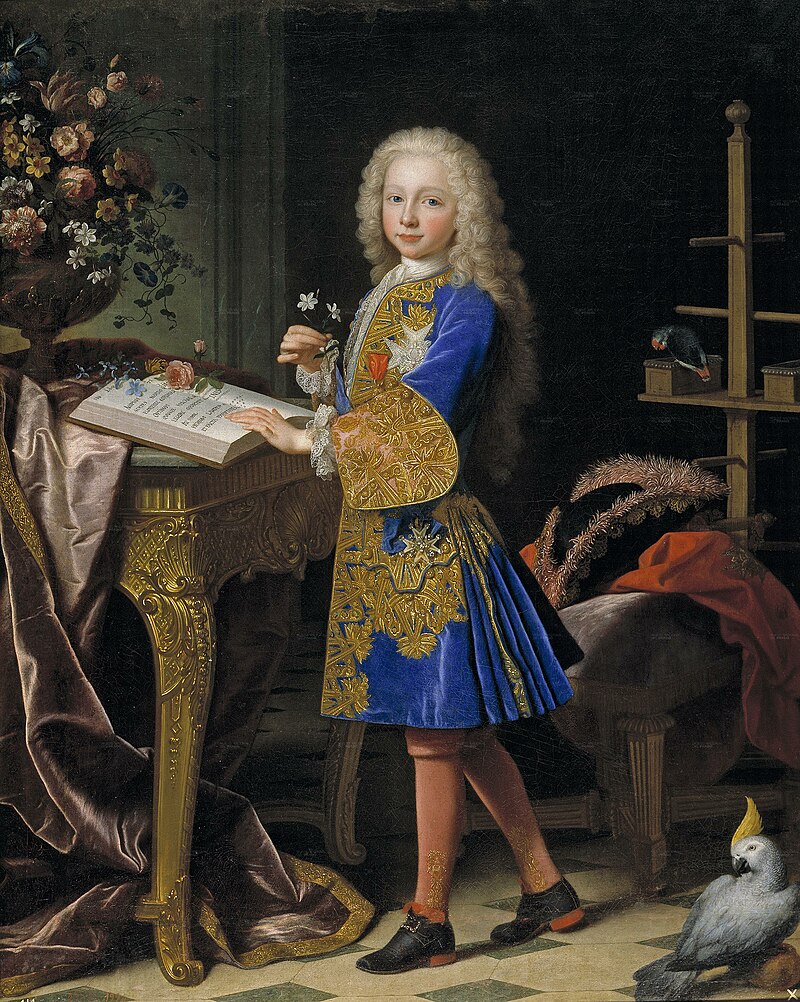The justaucorp existed during the entire ancien regime at Versailles as one of the foundations of male fashion. Basically, the justaucorp is the overcoat worn over breeches and a waistcoat. It has often been compared to a frock coat but this is not quite correct since the frock coat is less ornate and more subdued in both silhouette and execution.
It is one of the only articles of the male silhouette to change noticeably during this period. For convenience sake let us take a look at the development:
Second half of the 17th century:
The justaucorp had slowly replaced the doublet. There was no collar and the justaucorps reached the calf. It had buttons all the way down the front but was usually only buttoned at the neck which created an inverted V-shape. The "skirt" of the justaucorp - from the waist down - took after the female counterpart and was stiffened off with whalebone or a like material. It was often equipped with deep pockets but these were placed so low on the coat that the wearer could hardly use them. However, they were immensely decorated. The fabrics reflected the class which typically wore them; the nobility used heavy damask fabrics, silks, brocade and wool. The justaucorps were often distinguishable with their large cuffs which were folded back.
First half of the 18th century:
The pockets had by now moved up to where they could actually be reached and the cuffs no longer folded back. The "skirts" reached their zenith in size which was made possible by only having buttons to waist and leaving the skirt pleats wide. To highlight the wider skirt the opening was rounded rather than being in a reversed V-shape.
Second half of the 18th century:
The justaucorp was now far more fitted to the wearer's body and only reached just below the hips (not a far cry from today's tuxedo-jackets). This slimming of the silhouette was largely due to developments in the military's uniforms which became a great deal better fitted - as it happens the justaucorp had made its way into high society through the army's influence. Velvet had become a popular fabric but silk and damask were still the favourites among the gentlemen at court. By this point the exquisite embroidery were very much the focus-point of a man's court outfit.
It was no longer referred to as a justaucorp per say since it was now an integrated part of the habit.
Throughout these periods both embroidery and precious buttons were used to decorate the attire. The embroideries of men's fashion is by no means less extravagant than their ladies' - it was considered a duty to dress according to rank for both men and women. Buttons, too, received their fair share of embroidery but would more often than not have precious stones attached to them.
Louis XIV attached particular meaning to a specific type of justaucorp called the justaucorp à brevet. It was characterised by being of blue colour with silver or gold embroidery and was only given to those who had accompanied the King on trips to Marly or had been granted specific permission. It was considered quite an honour to be offered such a piece of clothing but other than that it carried no rights. Louis XIV created a patent on 4 February 1665 stating that only a select few could wear this particular colour combination (blue with gold/silver trimmings) while all others were prohibited without an express permission from the King. Originally, it was to show favour to the Prince de Condé.
An example of how much of an honour it was considered is clearly seen in the memoirs of Bussy-Rabutin who overjoyed could write down that he had receive such a coat. However, the justaucorp à brevet did not last long and was even outdated before the death of Louis XIV.
BONUS: Look-book
As seen in portraits:
 |
| Frederick I of Prussia |
 |
| Luis Francisco de la Cerda |
 |
| Baron de Breteuil |
 |
| A very young Louis XV |
 |
| Presumed to be Elie de Beaumont |
 |
| Carlos III of Spain |
 |
| The Grand Condé and his heir |








No comments:
Post a Comment